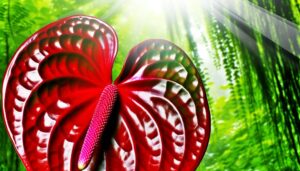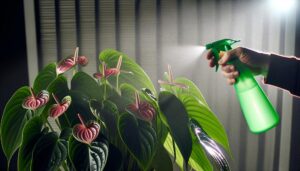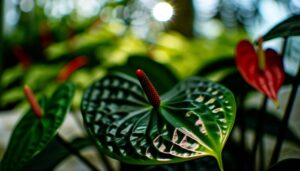The Ultimate Guide to Anthurium Veitchii Care
Proper care for Anthurium veitchii, or King Anthurium, necessitates bright, indirect light and avoiding direct sunlight. Water every 7-10 days using dechlorinated water, ensuring consistently moist yet well-drained soil comprising orchid bark, perlite, and peat moss.
Maintain humidity at 70%-80% and temperatures between 65-80°F (18-27°C). Fertilize with a 1/4 teaspoon of diluted fertilizer per gallon from spring to late summer, keeping soil pH between 5.5 and 6.5.
Watch for yellowing leaves as indicators of watering or nutrient issues, and protect against pests such as spider mites and aphids. Optimum results necessitate further meticulous attention.
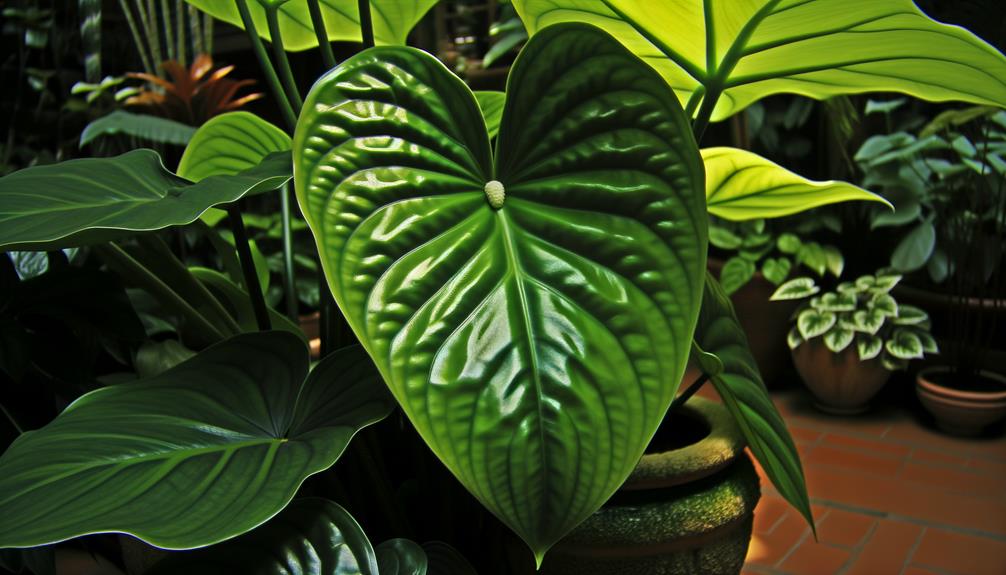
Key Takeaways
- Place Anthurium Veitchii in bright, indirect light and avoid direct sunlight to prevent leaf burn.
- Water every 7-10 days using dechlorinated or rainwater, ensuring the soil remains moist but not saturated.
- Use a soil mix of orchid bark, perlite, and peat moss, and refresh annually for optimal growth.
- Maintain high humidity levels (70%-80%) using humidifiers or misting, and keep temperatures between 65-80°F (18-27°C).
- Fertilize with a diluted solution (1/4 teaspoon per gallon) from spring to late summer, ensuring soil pH stays between 5.5 and 6.5.
Light Requirements
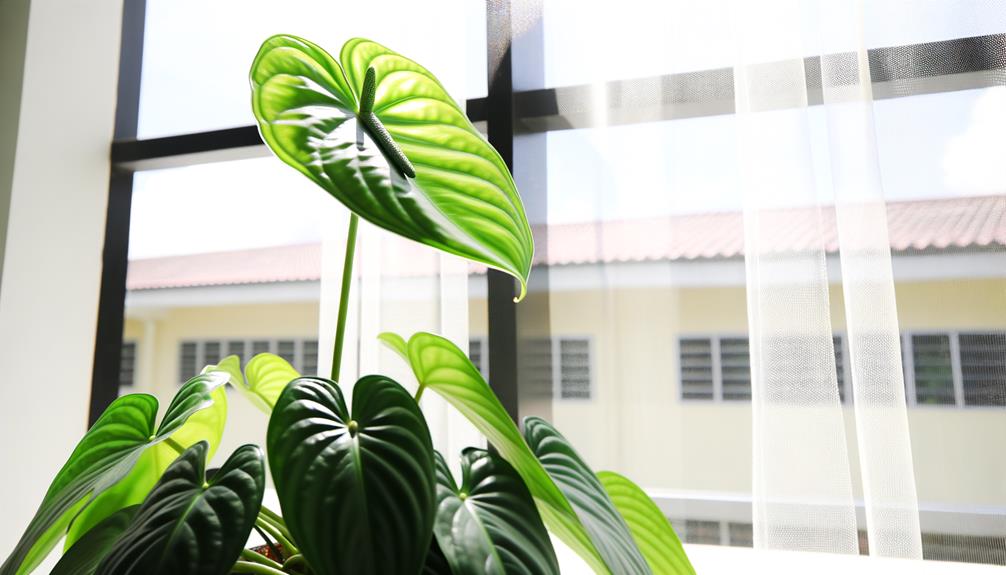
Anthurium Veitchii thrives best under bright, indirect light, which mimics its natural understory habitat in tropical rainforests. Direct sunlight can cause photodamage to its leathery foliage, characterized by leaf burn and chlorosis.
Positioning the plant near an east or north-facing window is ideal, as these orientations provide consistent ambient light without the intensity that could harm the plant.
Alternatively, if placed in a south or west-facing setting, make sure a sheer curtain diffuses the sunlight. Inadequate lighting conditions can lead to etiolation, where the plant becomes leggy and exhibits stunted growth.
Supplemental artificial lighting, such as fluorescent or LED grow lights, can be used to maintain prime light levels, particularly during darker winter months or in low-light indoor environments.
Watering Schedule
Establishing a best watering schedule for Anthurium Veitchii is essential for promoting healthy growth and preventing common horticultural issues.
The ideal watering frequency is dependent on factors such as ambient humidity and soil composition, with signs of overwatering including yellowing leaves and root rot.
Employing best practices, such as using lukewarm, filtered water and ensuring proper drainage, can greatly improve the plant’s overall well-being.
Ideal Watering Frequency
Maintaining an ideal watering schedule for Anthurium Veitchii involves understanding the plant’s preference for consistently moist, but not waterlogged, soil conditions. This balance is essential for promoting healthy root development and overall plant vitality.
To achieve this, consider the following guidelines:
- Watering Frequency: Water approximately every 7-10 days, adjusting based on humidity levels and soil moisture.
- Soil Moisture Monitoring: Use a moisture meter to ensure the top inch of soil remains moist but not saturated.
- Water Quality: Utilize dechlorinated or rainwater to avoid chemical buildup that can harm the plant.
- Seasonal Adjustments: Reduce watering frequency during the dormant winter months when the plant’s growth rate decreases.
Adhering to these practices will help maintain ideal hydration for your Anthurium Veitchii.
Signs of Overwatering
Monitoring your watering schedule is also essential to prevent overwatering, which can lead to several detrimental symptoms in Anthurium Veitchii.
Overwatering often manifests through root rot, yellowing leaves, and a wilted appearance despite the soil being moist. It is vital to recognize these signs early to mitigate damage.
| Symptom | Description |
|---|---|
| Yellowing Leaves | Leaves turn yellow due to excess moisture stress. |
| Wilting | Plant appears wilted despite adequately moist soil. |
| Root Rot | Roots become black and mushy, emitting a foul odor. |
| Edema | Swollen, blister-like growths on leaves or stems. |
| Mold Growth | Presence of mold or fungus on soil surface. |
Best Watering Techniques
Achieving ideal hydration for Anthurium Veitchii involves employing a strategic watering schedule that balances soil moisture levels, thereby preventing both drought stress and waterlogging.
To optimize plant health, consider the following expert techniques:
- Consistent Moisture: Maintain consistently moist but not saturated soil. Utilize a well-draining potting mix to prevent root rot.
- Water Quality: Use distilled or rainwater to avoid mineral build-up that can harm the roots.
- Humidity Considerations: Increase ambient humidity through misting or a humidifier, especially in dry climates.
- Seasonal Adjustments: Adjust watering frequency based on seasonal changes; water more frequently in the growing season (spring and summer) and less in the dormant period (fall and winter).
Implement these methods to guarantee your Anthurium Veitchii thrives.
Soil Preferences
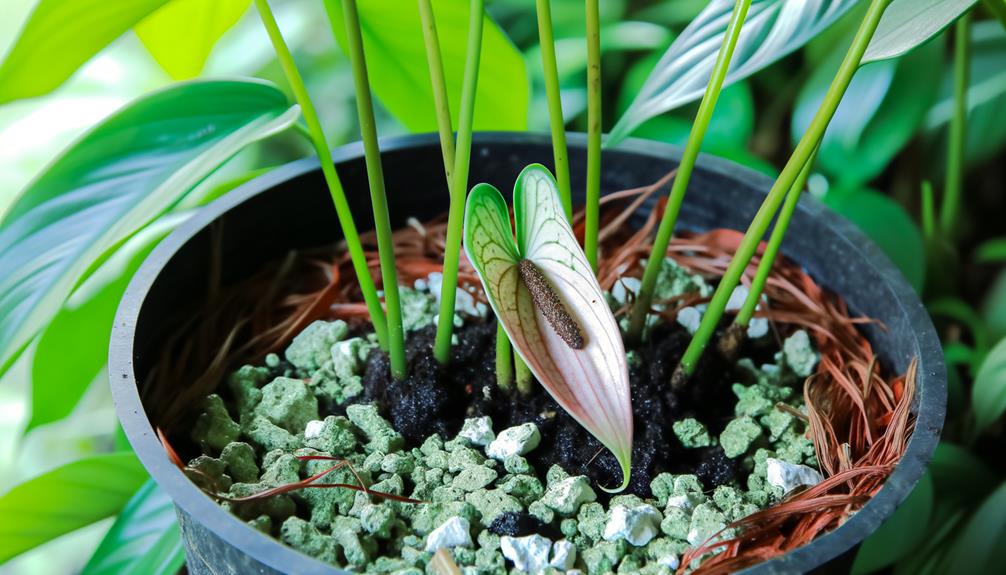
Ideal soil composition for Anthurium Veitchii involves a well-draining mix that typically includes a combination of orchid bark, perlite, and peat moss to mimic its natural epiphytic environment.
This blend guarantees optimal aeration and moisture retention without waterlogging the roots, which is essential for preventing root rot. Orchid bark provides necessary structural support and air pockets, facilitating root oxygenation.
Perlite enhances drainage and prevents soil compaction, while peat moss retains moisture and contributes to the organic matter in the mix.
Additionally, incorporating charcoal can help absorb impurities and enhance soil health. Regularly check the soil for compaction and refresh the mix annually to maintain its effectiveness.
Proper soil composition is fundamental for thriving Anthurium Veitchii growth.
Humidity Needs
Proper soil composition is essential for thriving Anthurium Veitchii growth, and equally significant is maintaining a high humidity level, ideally between 70% to 80%, to replicate its native tropical habitat.
To achieve and sustain this humidity, consider the following advanced techniques:
- Humidifiers: Utilize a high-capacity humidifier to consistently maintain the desired humidity range.
- Misting: Regularly mist the foliage with distilled water to prevent mineral buildup.
- Humidity Trays: Place the pot on a humidity tray filled with water and pebbles to increase local humidity.
- Grouping Plants: Positioning multiple tropical plants together creates a microenvironment with elevated humidity levels.
These methods ensure ideal moisture levels, essential for the Anthurium Veitchii’s lush, glossy foliage and overall health.
Temperature Range
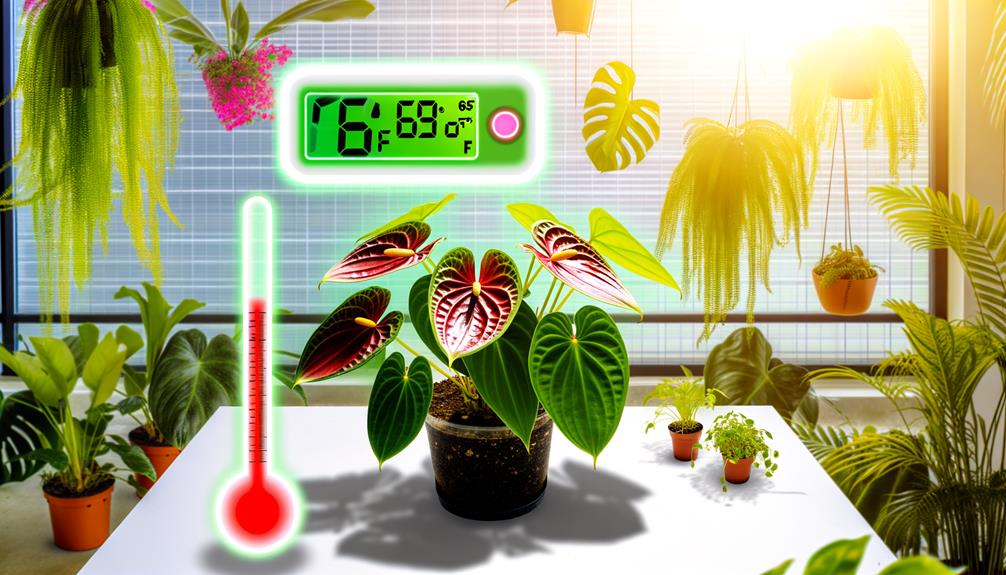
Maintaining an ideal temperature range is vital for the health of Anthurium veitchii, with perfect growing conditions falling between 70°F and 85°F (21°C and 29°C).
Temperatures outside this range can induce stress, leading to symptoms such as leaf discoloration and reduced growth rate.
To mitigate temperature-related stress, guarantee consistent monitoring and regulation of the plant’s environment using reliable thermometers and climate control systems.
Ideal Growing Temperatures
Thriving in a temperature range of 65-80°F (18-27°C), Anthurium veitchii requires consistent warmth to maintain best growth and health. This equatorial species is highly sensitive to temperature fluctuations, which can impact its physiological processes.
To optimize its environment, consider the following guidelines:
- Steady Temperature: Maintain constant temperatures, avoiding sudden drops below 60°F (15°C) or spikes above 85°F (29°C).
- Microclimate Management: Utilize thermostats and heaters in cooler climates to guarantee stability.
- Humidity Correlation: Higher temperatures necessitate elevated humidity levels (60-80%) to prevent leaf desiccation.
- Seasonal Adjustments: During colder months, make certain the plant is kept away from drafty windows or uninsulated walls.
Adhering to these principles will guarantee your Anthurium veitchii flourishes.
Temperature Stress Signs
How can you identify temperature stress in your Anthurium veitchii to guarantee its best health and growth?
Temperature stress often manifests through visible signs such as leaf discoloration, wilting, and slow growth.
Ideal temperature ranges for Anthurium veitchii are between 70-85°F (21-29°C) during the day and not below 60°F (16°C) at night. Prolonged exposure to temperatures outside this range can induce stress.
In cold conditions, leaves may develop brown edges, while excessive heat can cause yellowing and drooping.
Regularly monitoring room temperature with a reliable thermometer can help prevent these issues.
If stress symptoms appear, make sure the plant is relocated to a more stable environment, and consider using heating mats or air conditioning to maintain optimal conditions.
Fertilizing Tips
For ideal growth, Anthurium Veitchii requires a balanced, water-soluble fertilizer with a higher nitrogen content, applied bi-monthly during the growing season. Proper fertilization promotes robust foliage and vibrant blooms.
Follow these guidelines:
- Dilution Rate: Use a dilution rate of 1/4 teaspoon per gallon of water to prevent nutrient burn.
- Application Method: Apply fertilizer directly to the soil, avoiding contact with leaves to prevent foliar damage.
- Seasonality: Focus on fertilizing between spring and late summer, when the plant is actively growing.
- pH Balance: Maintain the soil pH between 5.5 and 6.5 for optimal nutrient uptake.
Adhering to these fertilization practices will promote the health and vigor of your Anthurium Veitchii.
Common Issues
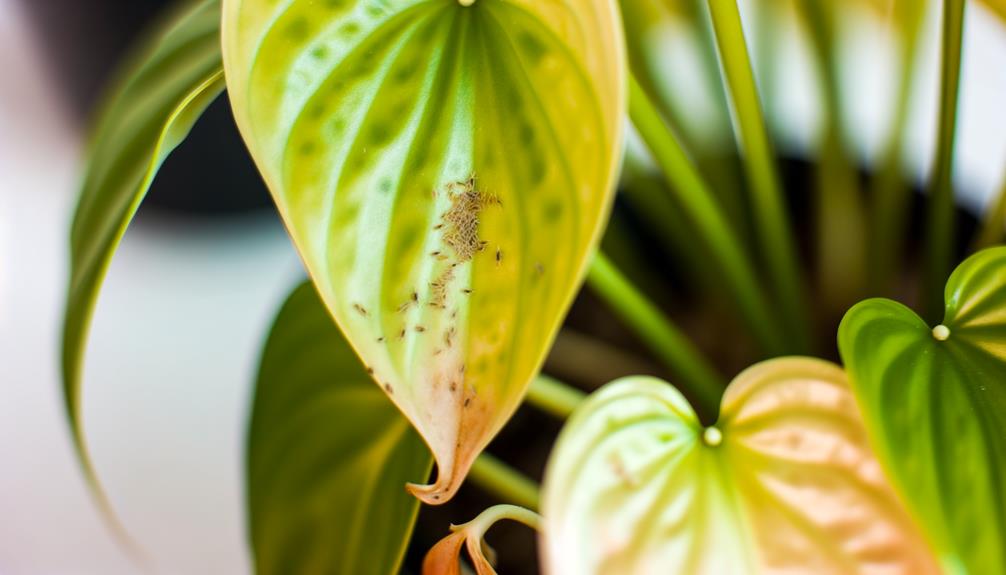
One of the most common issues encountered when growing Anthurium Veitchii is the yellowing of leaves, often indicative of improper watering or nutrient deficiencies.
Maintaining a balanced watering schedule is essential; overwatering can lead to root rot, while underwatering may cause desiccation. Use a well-draining soil mix and water when the top inch of soil feels dry.
Nutrient imbalances, particularly nitrogen deficiency, can show as chlorosis. Use a balanced, slow-release fertilizer to address deficiencies.
Additionally, maintain adequate humidity levels, as low humidity can lead to leaf browning and curling. Regularly check for pests such as spider mites and aphids, which can further stress the plant.
Addressing these issues promptly will support the plant’s overall health and vigor.
Conclusion
In summary, the proper care of Anthurium veitchii requires meticulous attention to:
- Light
- Watering
- Soil makeup
- Humidity
- Temperature
- Fertilization
By following these guidelines, one can guarantee the robust growth and health of this exquisite plant. Addressing common issues promptly will further enhance its vigor.
Essentially, the key lies in the details, and mastering these specifics can lead to a thriving Anthurium veitchii, displaying its striking foliage to the fullest potential.


